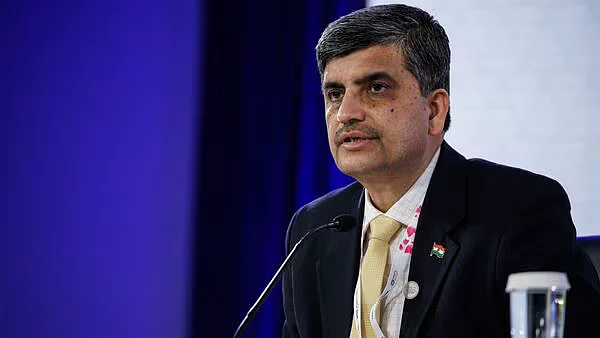The Economic Survey’s reference to 8 million jobs and the view that economic growth may not be generating sufficient employment, not accurately reflects the situation of the Indian economy, as the real problem lies in creating better-paying jobs, according to Ajay Seth, Department of Economic Affairs (DEA) Secretary.
In an interview with Outlook Business, Seth, citing government data said the reason why the Union Budget for 2024-25 also focused on skilling, besides job creation, is to improve the quality of pay.
"It is not just about the IT (information and technology) sector, which requires highly specialised skills, but also about improving skilled jobs on the shop floor," says Seth.
The DEA Secretary touched upon several aspects of the Indian economy and also talked about external developments related to credit rating agencies and sovereign debt's inclusion into global indices.
Edited Excerpts:
How much more of an increase we can expect from here in the fiscal pipeline given that government expenditure has been the biggest driver of the economy and private-sector is still not ready to take the baton?
As the finance minister mentioned in the budget speech, the government has provided significant support to infrastructure, which has served our economy well. The government’s endeavour is to maintain this strong support, subject to the demands on the economy, government resources, and the fiscal consolidation path we are following.
The allocation of Rs 11.1 lakh crore is 3.4 per cent of the GDP (gross domestic product), indicating a historically high level of support. In the past three years, we saw increases of 30 per cent and 35 per cent, starting from a level of one and half per cent of GDP. Having reached this level of over three per cent, maintaining this level, adjusted for nominal GDP growth each year, would be a good target to support.
I would like to qualify what you observe about the biggest drivers of the economy. To put it into perspective, the biggest drivers are total investments, particularly fixed capital investment, which is about 30 to 31 per cent of GDP. In this context, where does the government’s 3 per cent investment stand? It is a significant component, especially given its multiplier effect when spent on infrastructure.
This investment has provided a crucial impulse to the economy, and maintaining it at the annual budget level will be beneficial. Additionally, the budget expects state governments to provide similar support. Currently, all state governments combined have a capital expenditure level of about 2.5 per cent of GDP. From 2.5, can it become 3? Similarly, can the quality of the expenditure improve?
The finance minister also announced efforts to encourage private sector investment through a new financing framework. Therefore, in terms of infrastructure, there are three main players: the Government of India, state governments, and the private sector.
What is the road map to the ambitious fiscal deficit target of 4.5 per cent?
When the 5.1 per cent deficit was estimated (in Interim Budget), our expectation for the previous financial year, 2023-24, was 5.8 per cent. However, due to better revenues and some moderation in expenditure, the final numbers were 5.6 per cent. Our plan was to reduce the deficit by 0.7 per cent. If the estimate had remained at 5.1 per cent, the consolidation would have been only 0.5 per cent.
Our goal is to reach below 4.5 per cent next year. By bringing the deficit down to 4.9 per cent, we aim to achieve fiscal consolidation while meeting all essential and priority expenditures. This has been ensured in the budget, reflecting its theme. Having reduced the deficit, it should be relatively easier to achieve 4.5 per cent next year.
When the 2023-24 budget was presented, there were questions about whether it was possible to reach below 4.5 per cent. It seemed like a long way to go. Now, being much closer to that target, the question of feasibility is no longer being asked, indicating the government’s commitment to this path.
Amid serious criticism of biasness, one rating agency has changed its outlook on India from ‘stable’ to ‘positive’. Has this revived some hopes for a potential rating upgrade?
I do not subscribe to the view that rating agencies are biased against India. I do not hold that view. They are professional people doing their work, and we do our work as professionals.
We believe that the strength of the Indian economy, including India’s public finances, warrants a better rating. This is our view. We have regular conversations with rating agency professionals a few times a year to convince them of this. At the same time, they try to convince us that their risk assessments justify the current ratings. This conversation is ongoing, and I am hopeful that through sustained efforts, we will see a rating upgrade in the coming months or year.
When a foreign investor decides to invest in India, sovereign ratings, of course, play a part. These ratings determine the cost of foreign borrowings for our corporations. While we may have opinions about the rating agencies’ work, it is their job to assess risk. We were hopeful for an upgrade yesterday, we are hopeful today, and I am sure that we will be hopeful even tomorrow.
Have you made any preparations to handle the external volatility going to arise from the inclusion of sovereign bonds into global indices?
As we open up any asset class in India to foreign investors, we must be prepared to deal with the volatility that such flows may bring. The RBI (Reserve Bank of India) governor mentioned this in an interview a few months ago. How to handle that volatility depends on various factors and circumstances at that time. There is not a prescriptive way to address it; decisions must be made based on the specific context.
We are aware that opening any market, introducing new investors, or launching new products can bring challenges. And yes, we are ready for it. Economic management by the concerned authorities, including the regulators, always requires being on our toes.
A potential rate cut seems in sight when we see the recent monetary policy reviews. How much of an impact are you expecting on the growth momentum?
First of all, I would not like to comment on the decisions of the MPC (monetary policy committee). This is a body tasked with monetary policy, and they will make those decisions. Regarding the last three years, India has seen a very good growth trend. Excluding 2021-22, the years 2022-23 and 2023-24 were near normal. The year 2023-24 was entirely normal as most parameters had returned to pre-pandemic levels by the end of 2022. The economy has shown a decent growth rate, with estimates around 7 per cent for this year.
When evaluating monetary policy, it is important to consider the headline inflation rate as well. Regarding the growth rate, it is crucial to provide the right kind of impulse or momentum from fiscal policy. This involves shifting the quality of expenditure towards capital expenditure. A rupee sent on capital expenditure has a much larger impact on the economy. The government has been following this path while also focusing on fiscal consolidation. In the domain of fiscal policy, we are pursuing approaches that we believe are the most effective.
The Economic Survey suggests India should ideally create 8 million jobs a year, and on top of it, economists also argue that not sufficient jobs are being created with the current growth momentum. How much of an impetus should be provided to growth in this regard?
This budget includes significant proposals to boost job creation. It features a comprehensive package with five schemes, including the Prime Minister’s package for employment and skilling. The package encompasses short-term measures, medium-term initiatives focused on skilling, and long-term strategies to address the supply side of manufacturing.
Regarding the Economic Survey’s reference to 8 million jobs and the view that economic growth may not be generating sufficient employment, they might not accurately reflect the situation. If we examine EPFO (Employee’s Provident Fund Organisation) data for the last two years, excluding 2021-22, we see that about a crore (10 million) new people join EPFO each year. This data is public and shows both exits and re-entries. The net annual accretion to EPFO is approximately 13 million. This indicates that net job creation is around 13 million, not 8 million, as reflected in EPFO data. The real challenge lies in generating better-paying jobs.
The EPFO limit is set at Rs 15,000, but this does not prevent individuals earning Rs 25,000, Rs 50,000, or even Rs 1 lakh from joining the EPFO. However, the focus is on whether jobs are being created in the Rs 15,000 to Rs 20,000 range, or in the Rs 30,000 to Rs 50,000 range.
This is why we are emphasising skills development. It is not just about the IT sector, which requires highly specialised skills, but also about improving skilled jobs on the shop floor. Our large-scale skilling scheme aims to address this by involving state governments, the private sector, and industry associations.



























